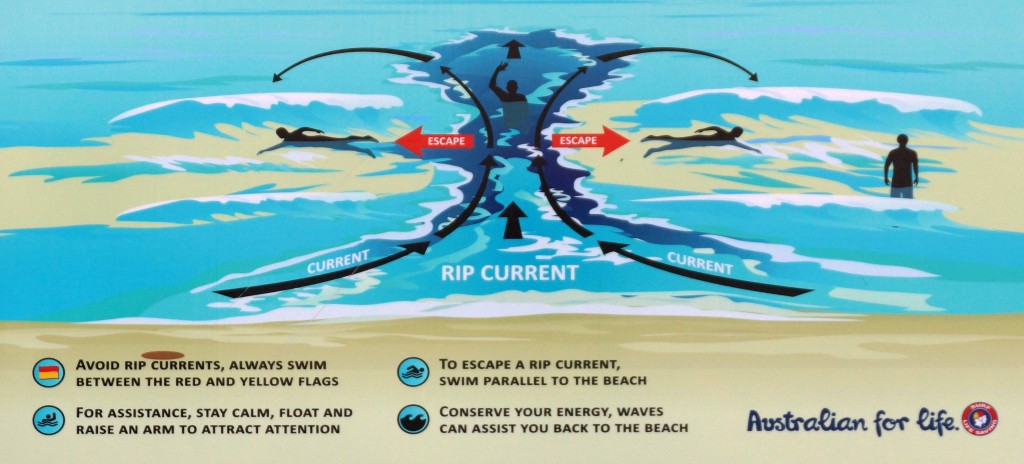Visiting the Beach is part of the Australian culture,and with so many iconic locations along our coastline, it is a ‘must do’ on many travel itineraries across this great land, however, it is important to be aware of the dangers. We always recommend swimming between the flags, swimming with a friend (never alone) and informing yourself of any potential dangers before you enter the water. Surf life savers are trained to understand the ocean and identify the risks associated with swimming at the beach and are always willing to help with answering any questions you might have about the dangers.
Some potential risks when swimming at the beach include:
– Rips Currents
Rips are present at all beaches. The simple fact is that the water washed in to shore by the waves has to return to the ocean and this movement of water back out to sea is called a rip.
Identifying a Rip
The area of the beach that appears to be calm or has smaller waves in often misconceived to be the safest place to swim when in actual fact this is one of the tell tale signs of a rip. As the water that is washed in shore by the waves retreats it will naturally flows down into the deeper water or channels where waves break less frequently or not at all, this is a rip current.
The key signs to look for are:
– Deeper darker water
– Fewer breaking waves
– Sometimes you may spot sandy coloured water extending beyond the surf zone
– Debris or seaweed may be visible
– Sometimes it’s easier to look for where the waves are breaking consistently, and then look to each side where they don’t break consistently. This is a rip current!
Negotiating a Rip
The most important thing to remember if you find yourself in the unfortunate situation of being stuck in a rip is don’t panic identify the direction the rip is moving and then begin to swim across the rip (generally across shore), no matter how stronger swimmer you may be you cannot out swim a rip.

Key Points to Remember are:
– Stay calm
– Float and raise your arm to attract attention
– Regularly stop to assess the situation to see if your strategy is being effective
– Swim across a rip towards the breaking waves, not against it
– Shorebreaks
Shorebreaks are waves that break directly onshore, they occur when there is a quick transition from deep to shallow water. These waves can be tremendously powerful presenting danger to anyone caught in there path. As the often break in shallow water dumping directly onto the sand it is not uncommon for injuries to occur as a result of being tumbled in the wave or being driven into the sand
– Sunburn
The sun in Australia can be very harsh and can ruin a holiday very quickly causing sunburn, heat cramps, heat exhaustion, and heat stroke.
It is important to remember to where the appropriate sun protection and drink plenty of fluids. Prevention is the best cure.
– Sea life
Australia has many sea animals that may pose a threat to humans at the beach including sharks, crocodiles, stonefish, blue ringed octopus, jellyfish, etc. It is recommended that you should always seek advice to determine whether it is safe to enter the water and the hazards to look out for.
We caution that tides, swell, currents and rips of the ocean are unpredictable and must always be treated with caution and the utmost of respect. Swimming and water activities are recommended at patrolled beaches only . . .
.
For more ‘Travel Aus’ – ‘Tips & Tricks’ – click here

